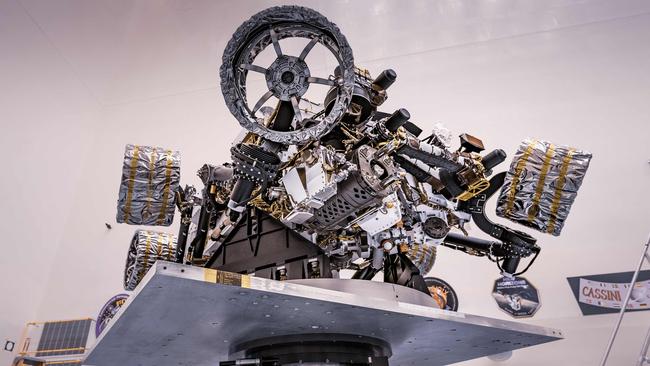NASA perseveres with signs of life on Mars
NASA’s most advanced Mars rover, Perseverance, launches from Earth on July 30 on a mission to find signs of ancient microbial life.

NASA’s most advanced Mars rover, Perseverance, launches from Earth on July 30 on a mission to find signs of ancient microbial life on what was a river delta 3.5 billion years ago.
Should the SUV-sized vehicle touch down unscathed in six months’ time, it will start collecting and storing rock and soil samples, which would be retrieved by a future mission and brought back to Earth in 2031.
Scientists will examine the samples obtained by Perseverance to look for fossilised bacteria and other microbes to try to confirm if aliens did once live on our neighbouring planet.
NASA has been teleworking for months because of COVID-19, but the launch calendar for this $US2.7bn ($3.7bn) mission hasn’t been affected. Earth and Mars are on the same side of the Sun only every 26 months, so it is a window that can’t be missed.
On February 18, Perseverance should land in the Jezero Crater, home to an ancient river that fanned out into a lake between three and four billion years ago, depositing mud, sand and sediment.
“Jezero is host to one of the best preserved deltas on the surface of Mars,” said Katie Stack Morgan, a member of the science team.
On our planet, scientists have found the fossilised remains of bacteria billions of years old in similar ancient deltas.
Perseverance follows in the tyre tracks of four rovers before it, all American, which first launched in the late 1990s.
Together with satellite and surface probes, they have transformed our understanding of Mars, showing that the red planet wasn’t always a cold and barren place. Instead, it had the ingredients for life as we know it: water, organic compounds and a favourable climate.
Perseverance probably won’t be able to determine whether a rock has ancient microbes.
To know for sure, the samples will have to be brought back to Earth where they can be cut into ultra-thin slices.
The six-wheeled rover is 3m long, weighs a tonne, has 19 cameras, two microphones and a 2m-long robotic arm. Its most important instruments are two lasers and an X-ray which, when projected on rocks, can analyse their chemical composition and identify possible organic compounds.
Also on board is the experimental mini-helicopter Ingenuity, which weighs 1.8kg. NASA hopes it will be the first chopper to take flight on another planet.
AFP


